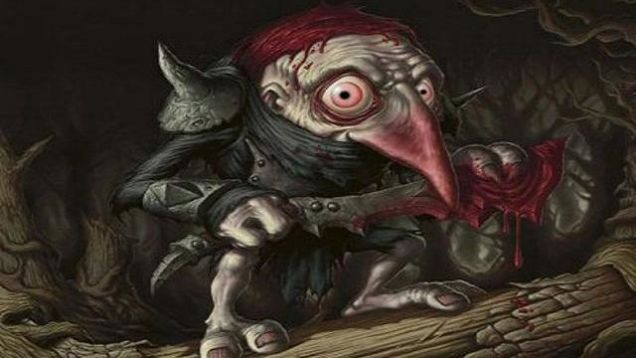Flesh-Eating Icelandic Elves February 22, 2015
Author: Beach Combing | in : Medieval , trackback[Brian Froud image?]
About a month ago Beach ran a post describing a fairy ritual from early medieval Iceland, albeit one recorded in a twelfth-century life (see link for precious comments by Lief). Here is another example of an Icelandic work recording religious fairy lore. This is from Kormáks saga, a difficult to date work but one that recalls a tenth-century scaldic poet (with a strangely Irish name) and one that could be as old as the eleventh century: there is a gentle consensus that this is an ‘archaic’ saga.
Thorvard healed but slowly; and when he could get on his feet he went to see Thordis, and asked her what was best to help his healing. ‘A hill there is,’ answered she, ‘not far away from here, where elves have their haunt [Hóll einn er héðan skammt í brott er álfar búa í]. Now get you the bull that Kormák killed, and redden the outer side of the hill with its blood, and make a feast for the elves with its flesh. Then thou wilt be healed.’ So they sent word to Kormák that they would buy the bull. He answered that he would sell it, but then he must have the ring that was Steingerd’s. So they brought the ring, took the bull, and did with it as Thordis bade them do.
The passage that follows this one is difficult because it is a poem (in fact, the saga is arguably a frame to include as many of Kormák’s poems as possible), but it may describe the elves as ‘workers of wounds’. Let’s leave that improbability to one side though. In later fairylore there are many references to fairies eating dairy products with enthusiasm (the pixies being left a bowl of milk, say). There is also reference to fairies drinking alcohol, which may link into hints that they were given beer sacrifices in the Germanic world. But this reference to meat is (to the best of Beach’s knowledge) unparalleled save in the cases where some solitary fairies are credited with a taste for human flesh and blood. Is this because Icelandic elves liked meat or is it simply that a wound in flesh could only be healed with a consummate sacrifice, the flesh of an animal? We know of Álfablót or elven sacrifices from several Scandinavian sources, but there is an understandable lack of detail: written records (save sparse runes) was a Christian prerogative and there was not much interest in recording pagan details, whereas pagan generalities were interesting.
Other thoughts on this passage? drbeachcombing AT yahoo DOT com
24 Feb 2015: Leif writes in with authority here, ‘I know of but one tale where fairies (or the like) eat flesh, but the example is a folktale collected in the 19th century, even though the tale has a medieval precedent. In Asbjørnsen and Moe’s Norske Folkeventyr (1841), appears a tale called, ‘Kvernen som står og maler på havsens bunn’ (The mill that grinds at the bottom of the sea), in which a man enters hell and trades a ham for a magic handmill. The devils are willing to trade anything in order to get ham, because ‘ham is rare fare in hell’. I’ve seen other versions of the tale where there are dwarfs instead of devils. The story is set on Xmas eve. In Scandinavian tradition the supernatural is at its strongest on Xmas eve– the winter solstice, and ham is a traditional Xmas dinner. So rather than a strong tradition of meat eating elves, we have a narrative device through which a human can obtain a magical object. The tale is is Aarne-Thompson type 565, the Magic Mill. ‘Grottasöngr’, which is sometimes counted among the poems of the ‘Poetic Edda’, is the basis for this folktale, though the Old Norse poem doesn’t include the episode where the devils trade the mill for ham. Gudrun Thorne Thomsen calls the devils ‘hillfolk’, and her Asbjørnsen and Moe retellings are based in part on stories she heard as a child. So now you have flesh eating fairies. Thorne-Thomsen, Gudrun. East O’ the Sun and West O’ the Moon. Chicago: Row, Peterson and Company, 1912′ Fascinating!
24 Feb 2015: re the image EC writes in ‘Not Froud. It’s a picture done for the card game Magic: the Gathering, and it’s by one Dave Allsop: http://gatherer.wizards.com/Pages/Card/Details.aspx?multiverseid=370518‘ Hope Dave’s ok with the image’s use…



